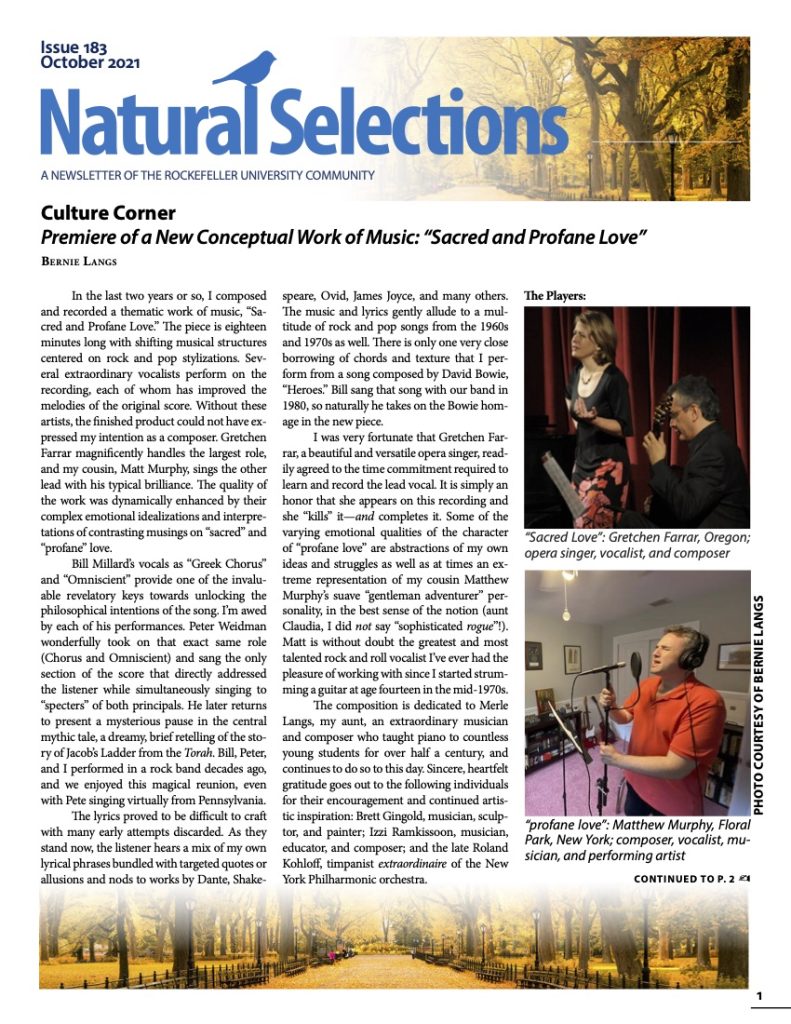Part XII: Stanford Moore and William Stein, 1972 Prize in Chemistry
By Joseph Luna

“RNAse-free.” To most any molecular biologist working with RNA, these two seemingly unrelated words are as sweet sounding together as “passion-fruit.” This is because ribonucleases, those small hardy enzymes that chew up RNA, can be found everywhere, are more invasive than the tiniest bacteria, and can utterly ruin an experiment. Seeing an “RNAse-free” label on one’s reagents is often a mark of trust that experimental results are on firm footing. But the story of RNase is a fascinating one, particularly at Rockefeller, for it is a story intricately wrapped in two names as tightly bound and harmonious together as “RNAse-free”: those of Stanford Moore and William Stein, or “Moore-n’-Stein”.
What can be considered one of the greatest life-long collaborations in biochemistry began simply, when Moore and Stein met as post-docs in the laboratory of Max Bergmann in 1939. Bergmann had fled Nazi Germany five years prior and took up a position at the Rockefeller Institute to continue his research on protein chemistry. A once long-time collaborator of Emil Fischer (who coined the term “peptide”), Bergmann and his lab were focused on finding ways to isolate and analyze proteins. By the mid 1930s, all twenty of the primary amino acid building blocks had been discovered, but it was unclear how they were put together to make a functional protein. What’s more, each protein that could be isolated appeared to have a different and unique composition of amino acids. Before one could get a grasp on protein structure, what was needed was a reliable way to determine how much of each amino acid a particular protein contained. This was the problem Moore and Stein first tackled.
They started by mixing together eighteen amino acids at known concentrations and asking if they could invent a method that could both separate and individually measure the concentration of each amino acid in the mixture. It was a daunting task, a bit like trying to uncook an egg. An early form of chromatography using starch columns eventually solved the first problem. Moore and Stein discovered that each of the eighteen amino acids passed through these columns at unique speeds, and so by adding the mixture at one end of the column and collecting fractions at the other, the mixture could be separated in a defined way: phenylalanine came out first, then leucine, then isoleucine and so on. And because standing around collecting fractions drop by drop was simultaneously laborious and boring, they invented a mechanical lab technician to precisely do the work: the automated fraction collector. The second problem, to measure the concentration of amino acids in the fractions, was solved by turning to a well-known chemical reaction known as the ninhydrin reaction. Chemists had discovered that in the presence of ninhydrin, amino acid solutions turned a bluish-purple with each amino acid giving off a unique, if unstable, hue. Moore and Stein figured out ways to stabilize the reaction such that the amount of blue could help determine both the identity of the amino acid, and its concentration.
It had taken the better part of a decade to invent the process and equipment, jointly described in 1948, which made it possible to determine amino acid composition. The tragic loss of Bergmann to cancer in 1944, to say nothing of world war and volunteered military service, no doubt played roles in hampering their protein analysis work. But because of its promise, Moore and Stein were appointed to lead a joint lab by Institute director Herbert Gasser in 1949, to continue their work. And they did, moving on from defined mixtures of amino acids to the true unknown natural mixtures of proteins. It turns out, they were just getting started.
Perhaps because of its ubiquity, small size, and ease of purification (first done at Rockefeller), RNAse became the top choice for detailed protein analysis. Moore and Stein realized that by subjecting RNAse to different proteases, which were known to cut between some amino acids but not others, they could obtain small fragments that could be subjected to their automated protein analysis. The “a-ha” moment was this: by figuring out the amino acid composition of each fragment, they could use this information to reconstruct the ORDER of amino acids in the protein. In other words, they could obtain its sequence.
In 1960, Moore and Stein, together with their first postdoc Werner Hirs, published the first complete amino acid sequence of the enzyme RNAse (the first for an enzyme, and the third for a protein, behind insulin and hemoglobin). RNAse was exactly 124 amino acids long and arranged linearly. Moreover, based on their results, Moore and Stein proposed the locations of di-sulfide bonds between cysteine amino acids that helped determine the 3D structure of the molecule.
Not content with merely its sequence, by 1963 they also determined that chemical inhibitors of RNAse could be used to mark the amino acids important for enzyme function. With this, they uncovered that only a few key amino acids performed the RNA cleaving chemistry that was the main job of RNAse. And thus, two words were newly joined to describe the “active-site” of an enzyme.

